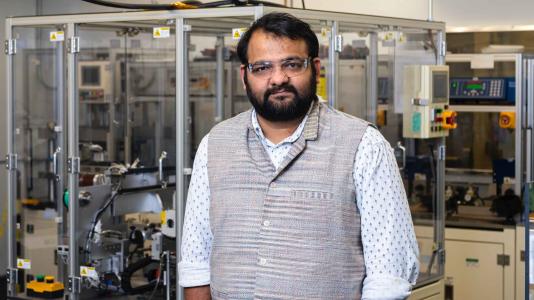BY MARGUERITE HUBER | APRIL 17, 2023
Marm Dixit, a Weinberg Distinguished Staff Fellow at Oak Ridge National Laboratory, was nominated for his work on imaging techniques for solid-state batteries.

Marm Dixit, a Weinberg Distinguished Staff Fellow at the U.S. Department of Energy’s (DOE) Oak Ridge National Laboratory, was named the 2023 recipient of the Rosalind Franklin Young Investigator Award.
Since 2004, this biannual award has been given by the Advanced Photon Source (APS) user organization. It recognizes important scientific or technical accomplishments at (or beneficial to) the APS by a young investigator, typically a senior graduate student or early career researcher. The APS is a DOE Office of Science user facility located at DOE’s Argonne National Laboratory.
The award is named for Rosalind Franklin, a chemist who played a critical, but largely unacknowledged role in the discovery of the structure of DNA.
“I am thrilled, ecstatic, and deeply humbled in equal measures on receiving the Rosalind Franklin Award from the APS. Every day I spent on the floor at APS, I learned something I had never known before, and I can’t wait to be back for more.” — Marm Dixit, Weinberg Distinguished Staff Fellow at Oak Ridge National Laboratory
Dixit was a visiting student with the Material Physics and Engineering group at the APS in June 2020. He worked closely with beamline scientists on developing and implementing advanced diffraction-based imaging methods for solid-state batteries. These types of batteries use solid electrolytes instead of liquid ones. His research dove into the characterization challenges unique to these batteries. It helped provide influential contributions and foundational knowledge in the field.
“I am thrilled, ecstatic and deeply humbled in equal measures on receiving the Rosalind Franklin Award from the APS,” said Dixit. “My sincerest thanks to everyone involved in all my beamtimes that helped to make this happen. Every day I spent on the floor at APS, I learned something I had never known before, and I can’t wait to be back for more.”
Over the course of his early career, Dixit already has 22 first-author publications (45 total), four book chapter publications, 10 patents (either granted or filed) and has received several fellowships and awards. His work has been integral in a range of fields. This includes batteries, energy conversion, water desalination, synchrotron science and manufacturing. In addition, Dixit has made exceptional scientific contributions in the field of in situ and operando X-ray characterization of materials.
Those who nominated Dixit applauded his scientific contributions, forward-looking approach and collaborative demeanor. His ability to conceive new ways to address technologically relevant problems using advanced synchrotron techniques will undoubtedly inspire others to take similar roads, his nominators concluded.
His ability to push the boundaries of cutting-edge synchrotron techniques and investigate solid-state batteries in new ways also impressed his nominators.
Dixit received his Ph.D. in Mechanical Engineering from Vanderbilt University and his Bachelor of Technology degree from Charotar University of Science and Technology.
About the Advanced Photon Source
The U. S. Department of Energy Office of Science’s Advanced Photon Source (APS) at Argonne National Laboratory is one of the world’s most productive X-ray light source facilities. The APS provides high-brightness X-ray beams to a diverse community of researchers in materials science, chemistry, condensed matter physics, the life and environmental sciences, and applied research. These X-rays are ideally suited for explorations of materials and biological structures; elemental distribution; chemical, magnetic, electronic states; and a wide range of technologically important engineering systems from batteries to fuel injector sprays, all of which are the foundations of our nation’s economic, technological, and physical well-being. Each year, more than 5,000 researchers use the APS to produce over 2,000 publications detailing impactful discoveries, and solve more vital biological protein structures than users of any other X-ray light source research facility. APS scientists and engineers innovate technology that is at the heart of advancing accelerator and light-source operations. This includes the insertion devices that produce extreme-brightness X-rays prized by researchers, lenses that focus the X-rays down to a few nanometers, instrumentation that maximizes the way the X-rays interact with samples being studied, and software that gathers and manages the massive quantity of data resulting from discovery research at the APS.
This research used resources of the Advanced Photon Source, a U.S. DOE Office of Science User Facility operated for the DOE Office of Science by Argonne National Laboratory under Contract No. DE-AC02-06CH11357.
Argonne National Laboratory seeks solutions to pressing national problems in science and technology. The nation’s first national laboratory, Argonne conducts leading-edge basic and applied scientific research in virtually every scientific discipline. Argonne researchers work closely with researchers from hundreds of companies, universities, and federal, state and municipal agencies to help them solve their specific problems, advance America’s scientific leadership and prepare the nation for a better future. With employees from more than 60 nations, Argonne is managed by UChicago Argonne, LLC for the U.S. Department of Energy’s Office of Science.
The U.S. Department of Energy’s Office of Science is the single largest supporter of basic research in the physical sciences in the United States and is working to address some of the most pressing challenges of our time. For more information, visit https://energy.gov/science.
